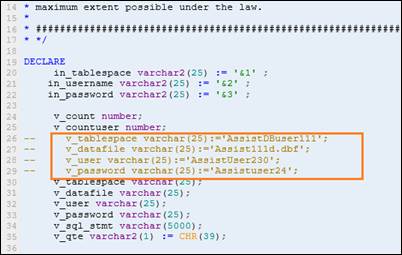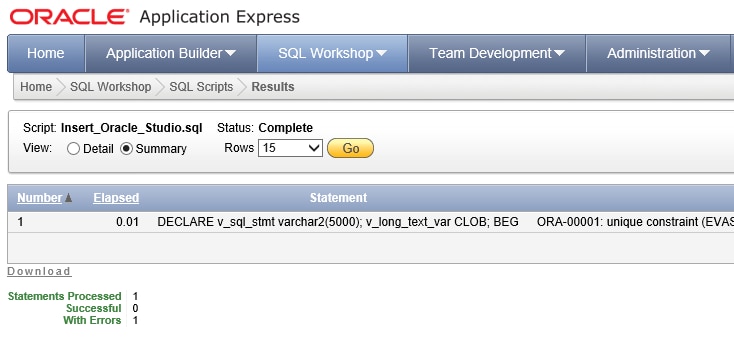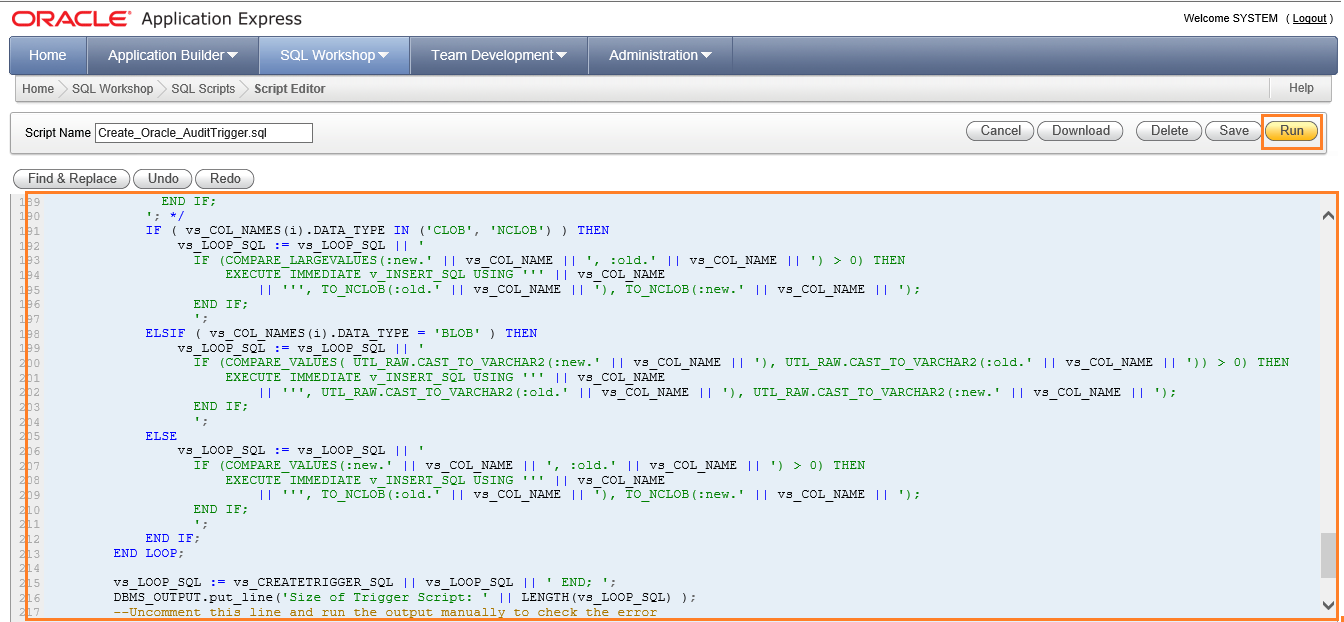Creating Database Manually using Scripts – Oracle Server
This section describes how to create database manually by running prepared scripts in the Oracle server. In order to start creating database manually, you are required to first locate the database script folder location and then execute the scripts.
|
NOTE: |
Before proceeding with the creating database manually using scripts, ensure that you have following:
|
Creating New Database using Scripts
This section explains you about creating a new database manually using scripts in the Oracle Server. You are required to execute the Oracle scripts mentioned in the below table for a successful deployment.
To create database manually using scripts:
- Navigate to SE_18.0_GA > Database > Installer > Scripts > Oracle > Oracle Scripts> New_Database.
- Open New_Database folder.
In the New_Database folder, you can access the following scripts in the respective folders.
|
Name of Scripts |
Path |
|
Create Database user for Oracle Server |
DatabaseUser\Create_DBUser.sql |
|
Create SQL tables for Oracle database |
Tables\Create_Oracle.sql |
|
Create Tables for Oracle Studio |
Tables\Create_Oracle_Studio.sql |
|
Insert Data |
Tables\Insert_Data.sql |
|
Insert Oracle Studio |
Tables\Insert_Oracle_Studio.sql |
|
Create Oracle Audit Trigger |
Tables\Create_Oracle_AuditTrigger.sql |
|
Create Admin User for Oracle |
SEAdminUser\CreateSEAdminUser_Oracle.sql |
- Connect to database.
- Access New_Database folder and navigate to OracleScripts > New_Database > DatabaseUSer > Create_DBUser .sql and open the script in Oracle Application express.

|
Name of Value |
Description |
|
@v_tablespace varchar |
Signifies the name of the new tablespace created where the database objects are added. |
|
@datafile |
Signifies the name of the datafile. |
|
@user varchar |
Signifies the name of the database user. |
|
@password |
Signifies the password for the database user. |
- Click Run.
- Upon successful execution of the script, disconnect from the database and establish a new databaseconnection using the username and password created in the above Step 4.
- Then, open the following scripts in Oracle Application express and Run them in sequence as mentioned below.
- Access “New_Database” folder and navigate to “OracleScripts > New_Database> Tables > Create_Oracle.sql” and open the script in Oracle Application express.
- Access “New_Database” folder and navigate to “OracleScripts > New_Database> Tables > Create_Oracle_Studio.sql” and open the script in Oracle Application express.
- Access “New_Database” folder and navigate to “OracleScripts > New_Database> Tables> Insert_Data.sql” and open the script in Oracle Application express.
- Access “New_Database” folder and navigate to “OracleScripts > New_Database> Tables> Insert_Oracle_Studio.sql” and open the script in Oracle Application express.
- Access “New_Database” folder and navigate to “OracleScripts > New_Database> Tables> Create_Oracle_AuditTrigger.sql” and open the script in Oracle Application express.
- After successful execution of above scripts, access “New_Database” folder and navigate to “OracleScripts > New_Database> SEAdminUser> CreateSEAdminUser_Oracle.sql” and open the script in Oracle Application express.
- Update the highlighted parameters in the script file with correct admin user details as described below:

|
Name of Value |
Description |
|
@unique_id |
Signifies the Unique ID of the AssistEdge admin user |
|
@first_name |
Signifies the first name of the AssistEdge admin user |
|
@last_name |
Signifies the last name of the AssistEdge admin user |
|
@display_name |
Signifies the display name of the AssistEdge admin user |
|
@email ID |
Signifies the Email ID of the AssistEdge admin user |
|
NOTE: |
|
- Click Run.
- Upon successful execution of the script, admin user is created for Oracle server.
For example, to create database manually using “Oracle Application Express”, refer Database Creation using Oracle Application Express.NOTE:
Database backup and restore are not in scope of the product. Third party tools can be used for performing DBA functions of backup and restore of DB.
Database Creation using Oracle Application Express
This section describes how to create and upgrade the database using scripts in Oracle Server using Oracle Application express by following below steps:
Creating database user for Oracle Server
To create a database user for Oracle Server:
- Login to Oracle database using the SYSDBArole.
- Connect to the database.
- Access “New_Database” folder and navigate to “OracleScripts > New_Database> DatabaseUSer > Create_DBUser.sql”and open the script in Oracle Application express.

|
Name of Value |
Description |
|
@v_tablespace varchar |
Signifies the name of the new tablespace created where the database objects are added. |
|
@datafile |
Signifies the name of the data file. |
|
@user varchar |
Signifies the name of the database user. |
|
@password |
Signifies the password for the database user. |
- Click Run.
- Upon successful execution of the script, Oracle Server Database setup is finished.

You can start using AssistEdge database for further installation process.
Creating Tables in Oracle
To create tables in oracle:
- Login to Oracle database using the SYSDBArole.
- Connect to the database.
- Access New_Database folder and navigate to OracleScripts > New_Database> Tables > Create_Oracle.sql and open the script in Oracle Application express.

- Click Run.
- Upon successful execution of the script, required tables are created in the Oracle Server.

- Access New_Database folder and navigate to OracleScripts > New_Database> Tables > Create_Oracle_Studio.sql and open the script in Oracle Application express.

- Click Run.
- Upon successful execution of the script, required tables are created in the Oracle studio.

Inserting data in tables for Oracle Server
![]() To insert data in table for Oracle Server:
To insert data in table for Oracle Server:
- Login to Oracle database using the SYSDBArole.
- Connect to the database.
- Access New_Database folder and navigate to OracleScripts > New_Database> Tables> Insert_Data.sql and open the script in Oracle Application express.

- Click Run.
- Upon successful execution of the script, required data is inserted in the tables for oracle server.

- Access New_Database folder and navigate to OracleScripts > New_Database> Tables> Insert_Oracle_Studio.sql and open the script in Oracle Application express.

- Click Run.
- Upon successful execution of the script, required data is inserted in the tables for Oracle Server.

Creating Oracle Audit Trigger
![]() To create audit trigger for Oracle Server:
To create audit trigger for Oracle Server:
- Login to Oracle database using the SYSDBArole.
- Connect to the database.
- Access New_Database folder and navigate to OracleScripts > New_Database> Tables> Create_Oracle_AuditTrigger.sql and open the script in Oracle Application express.

- Click Run.
- Upon successful execution of the script, required audit triggers are created in the oracle server.

Creating AssistEdge Admin user for Oracle Server
![]() To create AssistEdge Admin user for Oracle Server:
To create AssistEdge Admin user for Oracle Server:
- Login to Oracle database using the SYSDBArole.
- Connect to the database.
- Access New_Database folder and navigate to “OracleScripts > New_Database> SEAdminUser> CreateSEAdminUser_Oracle.sql”and open the script in Oracle Application express.

- Update the highlighted parameters in the script file with correct admin user details as described below:

|
Name of Value |
Description |
|
@unique_id |
Signifies the Unique ID of the AssistEdge admin user |
|
@first_name |
Signifies the first name of the AssistEdge admin user |
|
@last_name |
Signifies the last name of the AssistEdge admin user |
|
@display_name |
Signifies the display name of the AssistEdge admin user |
|
@email ID |
Signifies the Email ID of the AssistEdge admin user |
|
NOTE: |
In case of LDAP Authentication, ensure the values provided are of a valid user account from LDAP. In case of Custom authentication, create a valid user as per the custom authentication logic. |
- Click Run.
- Upon successful execution of the script, AssistEdge admin user is created for Oracle server.

Prerequisite Validation - Oracle Server
This section guides you with prerequisite validations of the Oracle server. A successful installation of the Oracle Server Database installs files to the file system, creates entries in the registry, and also install several tools.
To verify whether Oracle server is installed on your system:
- From the Start menu, select Programs, then Oracle - HOME_NAME.
- In the Welcome window, click Installed Products to display the Inventory dialog box.
- To check the installed contents, find the Oracle Database product in the list. Also, you can find the Oracle database icon on the desktop.